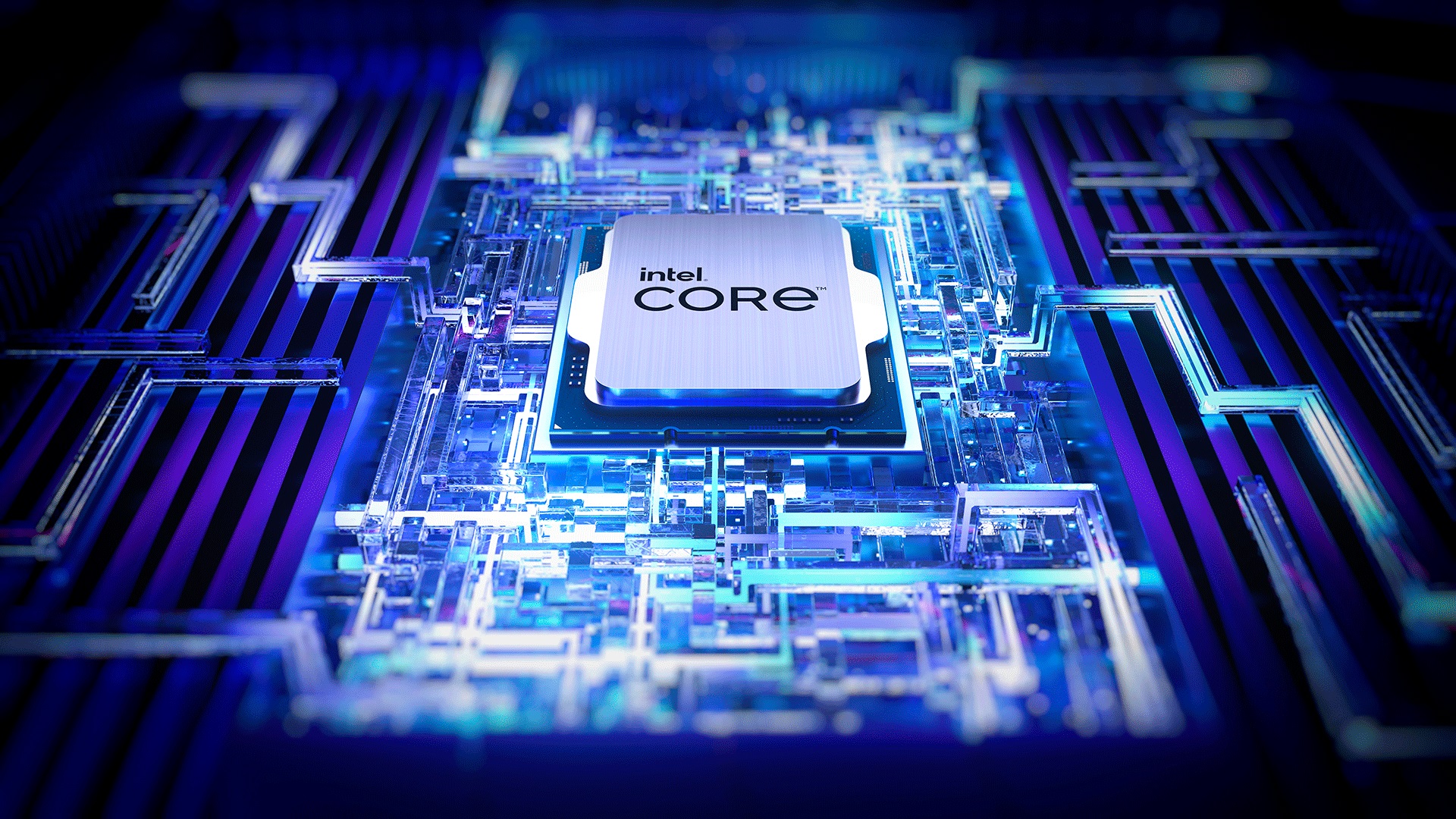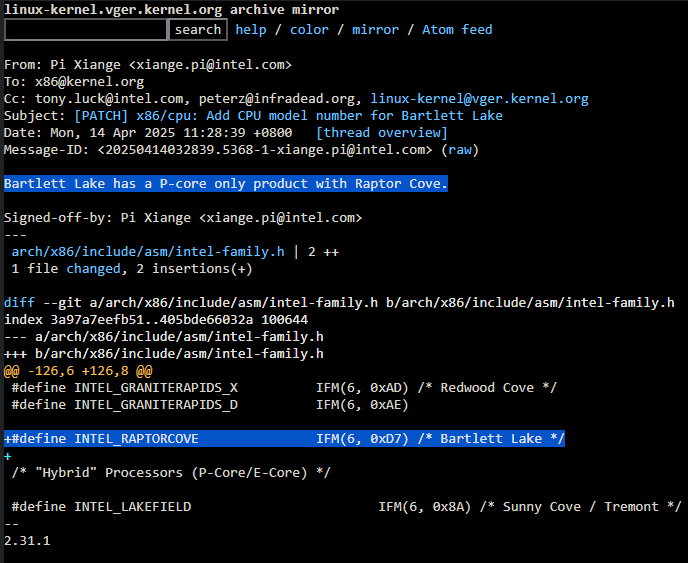Intel's P-Core only Bartlett Lake chip inches closer to reality with new Linux patch
It's unclear if these CPUs are intended for the mainstream or NEX.

A new Linux kernel patch brings hardware enablement for Intel's Bartlett Lake-S family of processors. In the same patch, an Intel engineer has seemingly confirmed the existence of a P-core-only counterpart to Bartlett Lake, via Phoronix. This update enables the kernel to properly identify these processors at boot, assigning them a CPUID for recognition in software. Likewise, these CPUIDs also allow the compiler to execute hardware-specific code path optimizations using the Intel CPU dispatcher mechanism.
At CES, Intel formally introduced the Bartlett Lake-S platform, which includes three CPUs configured with hybrid cores intended for NEX (Network and Edge) applications. Since last year, rumors have alleged the existence of a performance-core-only analog, wielding up to 12P cores and 24 threads. Bartlett Lake targets the LGA 1700 platform, so these CPUs should be drop-in replacements for existing 600-series and 700-series motherboards, after updating the BIOS, of course.
The Intel engineer added an identification entry for Bartlett Lake CPUs in the Linux kernel, assigning them to CPU Family 6, Model 215 (0xD7). These codenames allow the software to determine the processor family and whether it supports certain hardware instructions or not. The engineer additionally noted, "Bartlett Lake has a P-core only product with Raptor Cove", which effectively corroborates all previous leaks.

The Raptor Cove micro-architecture is an enhanced version of Golden Cove and powers the performance cores of Intel's 13th and 14th Generation processors. Pertinently, Bartlett Lake-S (P-core only) is reported to utilize a new die, as all Raptor Lake silicon is limited to just eight performance cores. The same leaker suggests these processors will debut in 125W/65W/45W configurations, catering to a wide variety of customers.
The elephant in the room is availability. Existing Bartlett Lake options are limited to embedded packages like COM-HPCs. Monolithic core configurations can clear up scheduling headaches and open a door for Intel to re-enable AVX-512 instruction support, which has been fused off silicon since later Alder Lake batches.
Bartlett Lake could be a double-edged sword; you'd likely see improved gaming performance, but at the cost of efficiency versus Arrow Lake. This might be a compromise gamers are willing to make, though, whether these chips can hold their own against AMD's Ryzen 9000 series remains to be seen. The rumor mill suggests a Q3 25 (July-September) release window for these processors, so we might be in for an announcement at Computex, next month.
Stay On the Cutting Edge: Get the Tom's Hardware Newsletter
Get Tom's Hardware's best news and in-depth reviews, straight to your inbox.

Hassam Nasir is a die-hard hardware enthusiast with years of experience as a tech editor and writer, focusing on detailed CPU comparisons and general hardware news. When he’s not working, you’ll find him bending tubes for his ever-evolving custom water-loop gaming rig or benchmarking the latest CPUs and GPUs just for fun.
-
usertests ReplyAt CES, Intel formally introduced the Bartlett Lake-S platform, which includes three CPUs configured with hybrid cores intended for NEX (Network and Edge) applications. Since last year, rumors have alleged the existence of a performance-core-only analog, wielding up to 12P cores and 24 threads.
So if I understand it correctly, P-core-only is off the menu since the real Bartlett Lake-S ended up being heterogeneous. I wonder what the telcos thought of those hybrid chips. -
bit_user Reply
Huh?usertests said:So if I understand it correctly, P-core-only is off the menu since the real Bartlett Lake-S ended up being heterogeneous. I wonder what the telcos thought of those hybrid chips.
Yes, at lower TDPs, Bartlett Lake does include some hybrid models that are Alder Lake or Raptor Lake rebadges. The upper-end is still P-only, and that's likely using new silicon. You can find the full list in this article:
https://wccftech.com/intel-arrow-lake-s-non-k-desktop-cpus-bartlett-lake-s-cpu-lineup-for-edge/ -
usertests Reply
Ok, there are a lot more of them than I remembered, with some of them including the E-cores.bit_user said:Yes, at lower TDPs, Bartlett Lake does include some hybrid models that are Alder Lake or Raptor Lake rebadges. The upper-end is still P-only, and that's likely using new silicon. You can find the full list in this article: -
bit_user Reply
It won't help you, because the low-TDP models you like will just be Alder Lake & Raptor Lake rebadges.Amdlova said:So my dead platform will receive new batch cpus :) -
thestryker Reply
That list is just Jaykihn's leak, not that they haven't been spot on, but Intel still hasn't officially acknowledged the P-core only parts. It would definitely have to be new silicon for anything above 8 cores.bit_user said:The upper-end is still P-only, and that's likely using new silicon. You can find the full list in this article:
The biggest question really is just how much they're producing. Putting them out at the consumer level is basically a giant marketing nightmare for everyone involved. I can't imagine OEMs having an interest in trying to sell them and the DIY market is tiny. I also doubt they'd be any faster than the existing SKUs at anything in the consumer space. -
sjkpublic Silly core nonsense. What do you do when your product peaks? You create silly spin offs. p-core, z-core, d-core. Electric power logic already built in so this silly core stuff is rather mute. This core differiation only adds to complexity and reliability and more lines of code. KISS. Keep it simple.Reply -
bit_user Reply
The application software running on a hybrid CPU usually has no special-case for such hardware. Normally, it's the same code that runs on both core types. It's normally left up to the kernel to decide which threads to run where, in order to maximize efficiency or performance.sjkpublic said:This core differiation only adds to complexity and reliability and more lines of code. KISS. Keep it simple.
On the matter of performance, companies like hybrid CPUs because E-cores have higher performance per mm^2 (which corresponds to perf per $). So, if your software can spin up enough threads, then it's faster (or at least more cost-effective) to use a hybrid CPU.
One of the main downsides of hybrid CPUs is in realtime applications, which I guess is why they're making a P-only CPU for realtime communications. Disabling E-cores also helps on some games, which you can think of as a kind of realtime application. -
Eximo I wouldn't turn it down. Also if they do an Arrow Lake refresh, they might get me for one more go. Intel to Intel board swaps tend to go pretty well for me.Reply